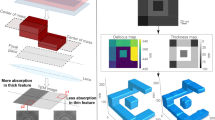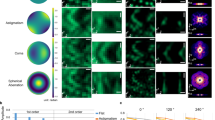Abstract
IN a recent communication1 Gregory and Donaldson describe a prototype microscope which produces a three-dimensional image. In this instrument the microscope and the viewing screen oscillate relative to the object so that the microscope scans the object in depth and the viewing screen follows in phase the real image produced. The frequency of the motion is such that an apparent image of each successive plane is maintained in space without appreciable flicker because of the retention of the image by the eye. Reasonable success was claimed at low magnifications, × 20 being about the greatest useful magnification.
This is a preview of subscription content, access via your institution
Access options
Subscribe to this journal
Receive 51 print issues and online access
$199.00 per year
only $3.90 per issue
Buy this article
- Purchase on Springer Link
- Instant access to full article PDF
Prices may be subject to local taxes which are calculated during checkout
Similar content being viewed by others
References
Gregory, R. L., and Donaldson, P. E. K., Nature, 182, 1434 (1958).
Author information
Authors and Affiliations
Rights and permissions
About this article
Cite this article
JACKSON, W. The Three-dimensional or Solid-Image Microscope. Nature 183, 1048–1049 (1959). https://doi.org/10.1038/1831048b0
Issue Date:
DOI: https://doi.org/10.1038/1831048b0
Comments
By submitting a comment you agree to abide by our Terms and Community Guidelines. If you find something abusive or that does not comply with our terms or guidelines please flag it as inappropriate.



